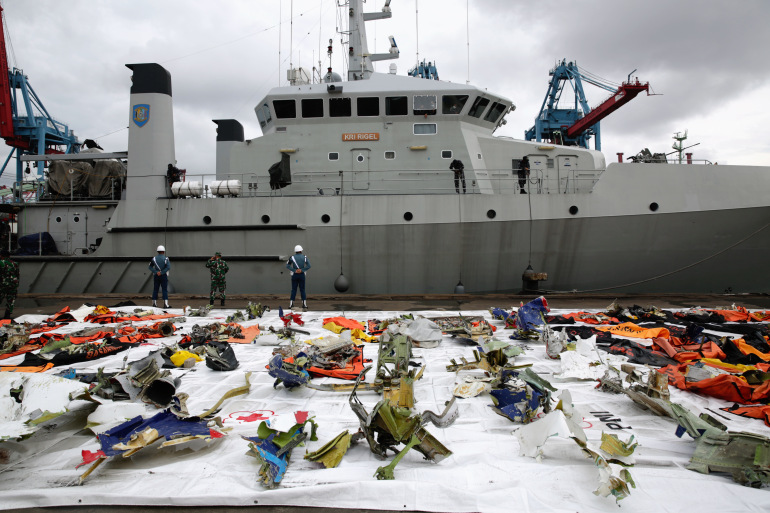Jakarta, Indonesia – Investigators are yet to determine the cause of this month’s Sriwijaya Air plane crash in Indonesia that killed all 63 people on board, but the disaster has once again put the spotlight on maintenance, training and safety across the country’s transport system.
“There are correlations between the poor safety records of different forms of transport in Indonesia,” Ziva Arifin, president of Aviatory Indonesia, a consultancy in Jakarta, told Al Jazeera. “But each individual sector faces unique challenges, and aviation is the sector that has seen the most significant safety improvements in recent years.”
Indonesia has recorded 104 civilian aircraft accidents and more than 1,300 related deaths since 1945, making it the Asia Pacific’s deadliest country to fly according to the Aviation Safety Network.
Risks rose markedly in 2001, when deregulation gave birth to a slew of new low-cost airlines, including Sriwijaya Air, which started operations two years later.
Amid cut-throat competition, a subsequent price war contributed to poor maintenance and a string of fatal air disasters.
By 2009, the number of accidents per million departing flights had risen to 18.35 compared with a world average of 4.11, according to the International Civil Aviation Organisation (ICAO), and Indonesian airlines had been banned from flying to the United States and the European Union.
Several new aviation laws introduced later that year forced airlines to invest in safety.
The result was a significant improvement in safety with the most recent ICAO audit showing Indonesia now ahead of the worldwide average in five out of eight categories, including accident investigations and airworthiness of planes.
The US and the EU have also dropped their bans on Indonesian airlines.
‘Tragedies at sea’
But there have been few improvements in other – less high-profile – forms of transport.
Indonesia has the highest number of boating and shipping accidents in the world, according to the Baird Maritime Passenger Vessel Accident Database.
Its data shows there have been 645 passenger vessel accidents in Indonesia since 2000 – more than any other country in the world – and 33,700 people have lost their lives.
The sheer number of boats operating in an archipelagic nation of 17,000 islands is a contributing factor. But so is the lax enforcement of safety regulations that regularly sees passenger and cargo limits ignored.
In 2018, more than 200 people died when a ferry licensed to carry 60 passengers sank in Lake Toba, a crater lake and popular holiday destination in Sumatra. In July, nine people drowned after a wooden boat licensed to carry 15 departed from Timor Island with twice that number on board and capsized.
“We have these constant tragedies at sea because safety inspectors at ports don’t do their jobs,” said Siswanto Rusdi, director of the National Maritime Institute in Indonesia. “According to the law, any vessel that leaves port must be visually inspected to check the number of passengers, the amount of cargo carried and the condition of the boat. But in practice, this rarely happens. Most safety inspectors spend their time playing cards instead.”
Ross Taylor, president of The Indonesia Institute, a think-tank in Perth, experienced first hand the dangers on a ferry to the Thousand Islands, the string of tropical islands near Jakarta’s north coast where Sriwijaya Air’s flight SJ182 crashed into the sea.
“At around the halfway mark a big storm hit and massive waves began smashing over the front window, drenching everyone inside,” he recalled. “I heard a deckhand yell to the captain ‘Turn back, turn back, or we will roll over!’ Passengers were screaming and vomiting but the captain pressed on. We made it in the end, but my wife was traumatised. She never wants to visit Indonesia again.”
He adds: “It was not a one-off experience. Anyone who travels on boats in Indonesia has similar stories.”
Road risks
Travelling by road is risky, too. Tens of millions of private vehicles, the absence of laws setting limits for blood alcohol concentration and traffic police who generally forgive violations for cash bribes has helped place Indonesia in fifth place for the highest number of road accidents in the world, according to the World Health Organization.
The nation’s vast fleet of buses is particularly prone to accidents because of a leave-when-full school of scheduling that encourages passengers to stand in aisles or sit on rooftops. When drivers apply brakes suddenly, tragedy easily follows.
 Ferries have a poor safety record with numerous accidents in recent years. In July 2018, at least 12 passengers died after a ferry sank off the coast of Selayar Island in South Sulawesi [Mustafa Syahril/EPA-EFE]
Ferries have a poor safety record with numerous accidents in recent years. In July 2018, at least 12 passengers died after a ferry sank off the coast of Selayar Island in South Sulawesi [Mustafa Syahril/EPA-EFE]
An only-replace-parts-when-they-break attitude to maintenance adds to the risk. On a bus trip in West Kalimantan province this month, Al Jazeera’s reporter noticed the driver had hooked up an old water bottle with a hose on the dashboard to feed fluid into the steering system.
Flouting traffic laws is also the main cause of the 300-odd accidents that take place at railway level crossings in Indonesia each year, according to the Indonesia National Traffic Accident data.
In 2019, a car carrying seven people in West Java was hit by a train, killing everyone on board, after the driver ignored the closed gate and alarm bells to try and get across the railway lines before the train. In June, a man narrowly escaped with his life after driving through an ungated railway crossing as a train was approaching and his car suddenly stalled.
A safety inspector for the Ministry of Transport in Jakarta who spoke on condition of anonymity because they are not authorised to speak to the press told Al Jazeera comprehensive laws and regulations apply to all forms of transport in Indonesia, He insisted all modes of public transport go through “rigorous” checks in advance of their departures.
 Families wait for news from the sunken ferry KM Sinar Bangun after the boat sank on Lake Toba in North Sumatra [Dedi Sinuaji/EPA]
Families wait for news from the sunken ferry KM Sinar Bangun after the boat sank on Lake Toba in North Sumatra [Dedi Sinuaji/EPA]
Despite improvements, Indonesia’s aviation industry still has some way to go.
“While big, fatal crashes are not as common as before in Indonesia, you still see a good number of near misses, such as runway excursions following unstable approaches,” said Greg Waldron, Asia managing editor at FlightGlobal, an aviation industry news site. “There are still signs that a comprehensive safety culture is yet to take root.”
He says the grounding of commercial jets during the pandemic is also a concern: “A number of aircraft have been in storage for quite a while, and pilots’ skills are also a bit rusty given the relative lack of flying last year.”
Searching for answers
Heavy rainfall that delayed the departure of Air Sriwijaya’s doomed flight SJ182 on January 9 may also have been a contributing factor in the accident.
A study by the University of New South Wales’s School of Aviation found bad weather contributed to 58 percent of air crashes in Indonesia compared with a global average of 24 percent.
Yet the most common contributing factor, the study found, was an interaction between the cockpit crew. And a communication breakdown between Sriwijaya’s pilots and air traffic controllers has emerged as an early focus of the investigation.
Gerry Soejatman, an aviation consultant in Jakarta, says the lack of response by the pilots in the minutes preceding the crash could suggest the pilots were distracted by mechanical failure.
 Debris from Sriwijaya Air plane laid out at Tanjung Priok port in Jakarta [Adi Weda/EPA]
Debris from Sriwijaya Air plane laid out at Tanjung Priok port in Jakarta [Adi Weda/EPA]
“Pilots are trained to fly the aircraft first, navigate the aircraft second and communicate with air controllers last,” he explains. “If the crew was dealing with a problem they thought they could solve, it makes sense that they wouldn’t respond. Mechanical failures are not something we can rule out.”
The Indonesia Institute’s Taylor, also a former chairman of the Chartered Institute of Transport of Australia and a former executive in the international air cargo industry, says a combination of poor maintenance and crisis training contributes to many transport accidents in Indonesia.
“When things go wrong in Indonesia it can often lead to disaster because whoever is in charge hasn’t necessarily been trained on how to deal with emergencies,” he said.
“And the quality of their equipment, things like radar that can help the pilot deal with emergencies, is often found wanting. We know Sriwijaya’s flight left in bad weather, so investigators will ask what kind of radar the aircraft had. It was probably an old-fashioned type that tells a pilot there’s a thunderstorm up ahead but can’t tell them if there’s another storm behind it like the state-of-the-art equipment can.”
Aviation consultant Soejatman confirms the 26-year-old Boeing 737-500 was still fitted with its original radar system, but stresses any discussion about the cause of the crash remains speculative for the time being.
Search teams have recovered the plane’s flight data recorder, which is likely to provide some clues about what happened. But they are still scouring the seabed for the memory card from the cockpit voice recorder which would reveal the crew’s final conversations.
It could be a while yet before the families of the victims find out just why SJ182 came down.
“Inspectors have said they will come up with a preliminary report within 30 days of the accident, but conclusions won’t be shared with the public until 12 months later – early next year,” Soejatman said.




